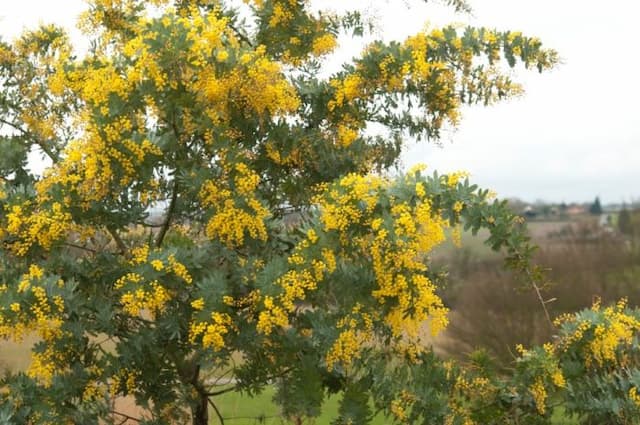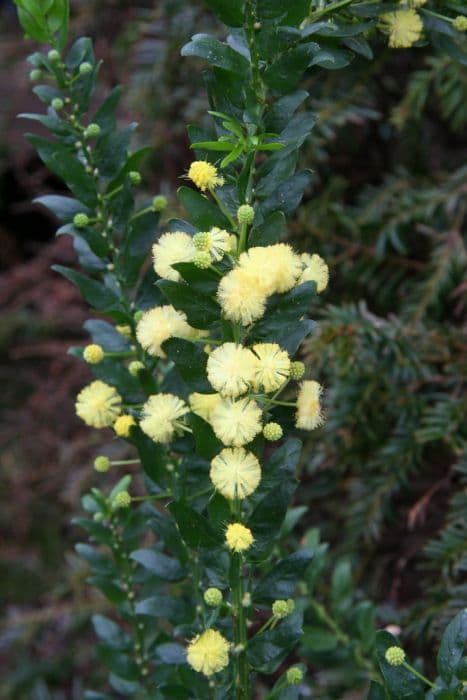Poinciana Caesalpinia pulcherrima

ABOUT
Commonly known as the Pride of Barbados, this vibrant plant boasts an exquisite display of flowers with a fiery palette of colors, ranging from yellow to deep red. The flowers are arranged in a corymb, which is a flat-topped cluster that adds to the overall showiness of the bloom. Each individual flower has five petals with one petal featuring a unique, elongated appearance, creating a dramatic contrast that is eye-catching. The foliage is feathery and fern-like, offering a delicate texture that complements the striking flowers. The leaves of the Pride of Barbados are bipinnate, which means they are composed of smaller leaflets arranged on either side of a central stem to form a larger leaf. These leaflets fold together in the evenings or during very hot weather as if in rest. The plant's stems are armed with sharp spines, providing a natural defense against herbivorous animals. Despite its thorny protection, the Pride of Barbados is a welcoming sight in any landscape with its lush foliage and mesmerizing, vivid blossoms. Its appearance can vary, especially regarding its flowering habit and overall bushiness. The fruit that follows the floral display is in the form of a pod, which dries and splits open when ripe, releasing the seeds contained within. These pods contribute additional visual interest to the plant and can persist even after the leaves have fallen. The overall appearance of the Pride of Barbados is tropical and exotic, making it a popular choice for gardeners looking to add a splash of color and texture to their outdoor spaces.
About this plant
 Names
NamesFamily
Fabaceae.
Synonyms
Peacock Flower, Red Bird of Paradise, Dwarf Poinciana, Pride of Barbados, Flamboyan-de-jardin, Barbados Fence Flower, Flos Pavonis, Mexican Bird of Paradise.
Common names
Poinciana pulcherrima, Poincianella pulcherrima, Caesalpinia poinciana, Poinciana bijuga, Caesalpinia bijuga.
 Toxicity
ToxicityTo humans
The most common name for Caesalpinia pulcherrima is Pride of Barbados. Pride of Barbados is considered to have a level of toxicity to humans. If ingested, the plant parts, particularly the seeds, can cause poisoning. Symptoms of poisoning may include gastrointestinal issues such as nausea, vomiting, and diarrhea. In severe cases, there could be liver and kidney damage. It is advised to avoid consuming any part of this plant and to seek medical attention if ingestion occurs.
To pets
The most common name for Caesalpinia pulcherrima is Pride of Barbados. This plant is toxic to pets. The seeds are known to contain toxic compounds and if ingested, can lead to symptoms such as vomiting, diarrhea, and abdominal pain. More severe symptoms can include lethargy, abnormal heart rate, and in some cases, liver or kidney damage. It is important to prevent pets from ingesting parts of the Pride of Barbados and to consult with a veterinarian promptly if exposure is suspected.
 Characteristics
CharacteristicsLife cycle
Perennials
Foliage type
Evergreen
Color of leaves
Green
Flower color
Red
Height
10 feet [3 meters]
Spread
10 feet [3 meters]
Plant type
Shrub
Hardiness zones
9
Native area
Americas
Benefits
 General Benefits
General Benefits- Ornamental Value: Caesalpinia pulcherrima, commonly known as Red Bird of Paradise, has vibrant flowers that enhance aesthetic beauty in gardens and landscapes.
- Habitat for Wildlife: The plant provides nectar for hummingbirds, butterflies, and bees, supporting local biodiversity.
- Erosion Control: With its deep root system, the Red Bird of Paradise can help stabilize the soil and prevent erosion.
- Drought Tolerance: As a drought-resistant plant, it requires minimal water once established, making it ideal for xeriscaping and water-efficient gardening practices.
- Shade Provider: The plant can grow into a small tree, offering shade in hot climates.
- Low Maintenance: It requires minimal care and is relatively free from serious pests and diseases, making it a user-friendly choice for gardeners.
- Cultural Significance: In some cultures, the Red Bird of Paradise is used in traditional ceremonies and festivals.
- Fast Growing: The plant has a rapid growth rate, allowing for quick establishment and gratification in the landscape.
 Medical Properties
Medical Properties- Antimicrobial: Caesalpinia pulcherrima, commonly known as the Barbados Pride, has shown antimicrobial activity that may help in treating infections.
- Anti-inflammatory: The plant has anti-inflammatory properties that could potentially aid in reducing inflammation.
- Antipyretic: The plant's extracts have been traditionally used to reduce fever.
- Analgesic: There could be pain-relieving properties associated with the plant's extracts.
- Antioxidant: The Barbados Pride might contain compounds with antioxidant effects that help in protecting against oxidative stress.
- Wound healing: There are traditional uses of the plant in promoting the healing of wounds.
- Antidiabetic: Some studies suggest the plant might have properties that can help in managing diabetes.
 Air-purifying Qualities
Air-purifying QualitiesThis plant is not specifically known for air purifying qualities.
 Other Uses
Other Uses- Pride of Barbados, the common name of Caesalpinia pulcherrima, can be used as a natural dye source, providing various shades of yellow, orange, and red hues for textiles.
- Its wood is sometimes utilized in carpentry for light construction or making musical instruments due to its workability and aesthetics.
- The plant can be incorporated into xeriscaping, a landscaping method that reduces or eliminates the need for supplemental water, making it ideal for drought-prone areas.
- Pride of Barbados has been used as a living fence, taking advantage of its dense growth and spiny branches to deter animals and trespassers.
- The flowers can serve as a source of nectar for bees, butterflies, and hummingbirds, promoting pollinator biodiversity in gardens.
- The seeds of Pride of Barbados are sometimes used in craftwork, such as the creation of jewelry or as beads in art projects.
- In educational settings, the plant can be used to teach botany and horticulture, especially regarding tropical and subtropical flora.
- Pride of Barbados can act as a windbreak or hedge to protect smaller plants and reduce soil erosion when planted in strategic locations.
- The plant's vibrant and diverse coloration can be used by landscape artists to create visually striking contrast and focal points in garden design.
- During cultural festivals or parades, the striking flowers of Pride of Barbados can be used as natural decorations or motifs on floats and costumes due to their brilliant colors and exotic appearance.
Interesting Facts
 Feng Shui
Feng ShuiThe Poinciana is not used in Feng Shui practice.
 Zodiac Sign Compitability
Zodiac Sign CompitabilityThe Poinciana is not used in astrology practice.
 Plant Symbolism
Plant Symbolism- Beauty and Aesthetics: As the common name "Pride of Barbados" suggests, the plant's exuberant, vibrant blooms are often associated with beauty and stunning visuals, making it a symbol of natural aesthetics.
- Resilience and Survival: This plant is known for its hardiness and ability to thrive in tough, dry climates, representing resilience and the capacity to survive challenging conditions.
- Warmth and Radiance: The fiery colors of the flowers, which range from bright reds to warm oranges and yellows, symbolize warmth, sunshine, and positive energy.
- Pride and Confidence: Reflective of its common name, the "Pride of Barbados" is a symbol of pride and confidence, embodying the plant's standout nature and prominent display.
- Attention and Attraction: Because of its bold and conspicuous flowers, the plant is often associated with gaining attention and is symbolic of attraction and magnetism.
 Water
WaterThe Pride of Barbados requires moderate watering. During active growth in the warm months, water the plant when the top inch of soil feels dry, typically once a week with around two gallons, depending on the size and age of the plant and environmental conditions. Reduce watering in the winter to every two to three weeks, with one to one and a half gallons, as the plant enters a period of dormancy and requires less moisture. Overwatering can lead to root rot, so ensure good drainage and allow the soil to dry between waterings.
 Light
LightThe Pride of Barbados flourishes best in full sunlight. It should be planted in a location where it receives at least six hours of direct sunlight daily to ensure vibrant flowering and healthy growth. Dappled light is tolerable for a portion of the day, but too much shade can lead to sparse blooms and leggy growth.
 Temperature
TemperatureThe Pride of Barbados prefers warm climates and is hardy in USDA zones 9 to 11. The ideal temperature range for this plant is between 60°F and 90°F. It can tolerate a minimum temperature of 30°F for short periods, but frost can damage the plant. It thrives in the warmth and may need protection or appropriate siting if temperatures regularly fall below these ranges.
 Pruning
PruningPrune the Pride of Barbados to maintain its shape and encourage bushier growth. It's best to prune in late winter or early spring before new growth starts. Prune off dead or weak branches, and cut back the plant by one-third to one-half its size to promote vigorous growth and blooming. It may require more frequent pruning in warmer climates where it grows year-round.
 Cleaning
CleaningAs needed
 Soil
SoilThe best soil mix for Poinciana or Pride of Barbados should be well-draining and fertile, with a mix of loam, peat, and sharp sand to facilitate drainage. A slightly acidic to neutral pH, ranging from 6.0 to 7.5, is ideal for the healthiest growth.
 Repotting
RepottingPoinciana (Pride of Barbados) does not require frequent repotting; it should be repotted every 2 to 3 years, ensuring that any pot chosen allows room for growth and has excellent drainage.
 Humidity & Misting
Humidity & MistingPoinciana (Pride of Barbados) prefers moderate humidity but is quite adaptable and can tolerate the dry conditions commonly found in home environments.
 Suitable locations
Suitable locationsIndoor
Place in bright light, avoid cold drafts, and ensure good air circulation.
Outdoor
Full sun, shelter from strong winds, ensure soil drainage.
Hardiness zone
9-11 USDA.
 Life cycle
Life cycleCaesalpinia pulcherrima, commonly known as Pride of Barbados or Peacock Flower, begins its life cycle when its seeds germinate in warm, moist soil conditions. After germination, seedlings emerge and grow into young plants, which develop compound, fern-like leaves and begin to establish a root system. As the plant matures, it develops woody stems and branches, reaching its full size, which can be up to 3 meters tall. During the flowering stage, Pride of Barbados produces vibrant red, orange, and yellow flowers with long protruding stamens, attracting pollinators and leading to fruit development. The fruits are flat seed pods that turn brown as they mature and split open to disperse the seeds. These seeds can then germinate to begin a new cycle, or the plant can also propagate through cuttings, allowing for vegetative reproduction.
 Propogation
PropogationPropogation time
Spring-Summer
The most popular method of propagation for the Pride of Barbados, or Caesalpinia pulcherrima, is through seeds. Typically, seeding should be performed in spring to give the plant an entire growing season to establish itself. The seeds have a hard outer coating, so they often require scarification or a light sanding before they are planted, as this helps encourage germination by allowing water to penetrate the seed coat more easily. The seeds should be sown in well-draining soil at a depth of about 1 inch (2.54 centimeters) and kept moist until germination, which usually occurs within a few weeks. Once the seedlings have sprouted and reached a sufficient size, they can be transplanted to their permanent location in full sun to partial shade, taking care to not disturb the taproot.









